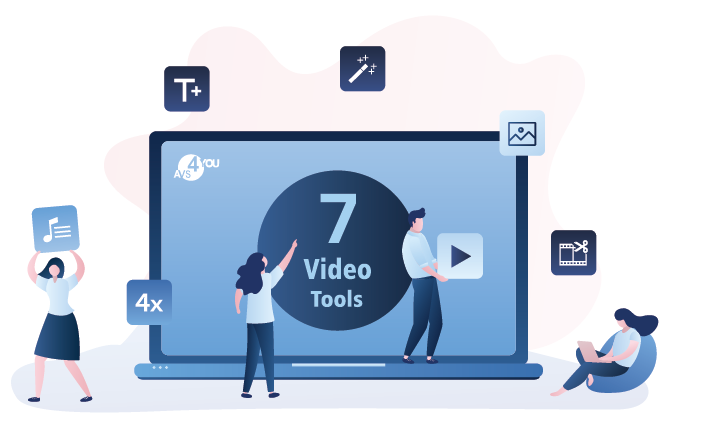Whether you are a professional or only starting your video editing practice, there’s a certain set of tools that are just essential in the process of creating a mastered video piece. Below, we prepared a list of seven core tools available in AVS Video Editor and explained how to use them.

1. Trimming video
Many users need to delete the unnecessary parts from their video files. AVS Video Editor has well organized handy tools to fulfill the task:
Trim option is quite useful when you need to cut out some video from the beginning or the end of the video clip, or both. Right click on the video you need to trim (either in media library or on the timeline) – choose Trim, then mark the beginning and end of the trimming area with your mouse and buttons circled on the screenshot below.
MultiTrim is used in case you need to delete several scenes in different parts of the video clip – beginning, end or any place in the middle. You can either manually select all the scenes in the video clip and choose what to keep and what will be deleted or find the scene changes automatically. The procedure of manual selection of needed area is the same with Trim option. Although it might be better to use the scene detection algorithm offered by AVS Video Editor. To do it, click the Detect Scenes button. After this is done, the found scenes will be displayed in the right part of the MultiTrim window.
Now you can select one of the scenes and click the Delete Scene button to remove the scene from the video.
2. Transitions
When unnecessary parts are deleted from your video, you will surely need to merge your videos, so they smoothly go into one another. The transitions can be added by simple drag-and-dropping them to the Timeline/Storyboard Area. So you can follow the steps:
- Click the Transitions button in the middle toolbar of AVS Video Editor;
- Switch into the Storyboard view using the Storyboard View button;
- Select the transition you would like to add to the video of yours, and click it with the left mouse button. Then, without releasing the button, drag the selected transition to the rectangle between the video clips and drop it there.
3. Text – add titles, comments, subtitles, credits to your video.
First select the Text button in the middle toolbar of AVS Video Editor. Then drag-and-drop the text with the mouse from the Files and Effects Area to the Timeline/Storyboard Area.
It is possible to change the duration and position of the text on the timeline. To add the text right click on the text item on the timeline – choose Edit text. In the new opened window you can enter the necessary text, choose the font, size, style, fade in\out animation, brush, shadow, edge and other text settings.
4. Audio editing
AVS Video Editor has a large set of tools for editing audio:
- changing the audio track of the video file being edited;
- muting the original audio track;
- recording voice;
- changing the volume, fade in and fade out audio track;
- applying different audio effects, such as Amplify, Noise Removal, Normalize and others.
I will not dwell on each of the tool. I’ll wait for your comments if you need more information on audio.
5. Color correction
AVS Video Editor allows you to adjust the tonal range, color, and sharpness of your video files. In order to improve the quality of the imported videos, please, place your video file to the Timeline and click the Color button on the Timeline Toolbar. Use the Auto Color Correction option to make the adjustments automatically. Or select one of the video effects depending on the problem you experience or the result you want to get: Brightness, Temperature, Contrast, Saturation, Gamma, Hue.
6. Video effects.
While processing your videos in the AVS Video Editor program you can also add different video effects to them, such as Zoom, Rotate, Blur, Film, Timer and many others. To apply the effect to your video switch to Video effects tab and place the video onto the timeline by drag-and-dropping it.
7. Playback speed.
AVS Video Editor allows you to change the playback speed of video content placed on the Timeline/Storyboard Area. Use this feature to correct too slow or too fast episodes speeding up or slowing down your clips. You can create interesting voice effects by adjusting playback speed. Faster speed makes the voice sound small and wacky and slow makes the voice sound large and ominous. Select the video clip on the Main video or Overlay video line by clicking it, then press the Speed button on the Timeline/Storyboard Toolbar.
Got any new ideas while reading about the essential editing tools in AVS? Time to give them a try on practice. Get the latest version of AVS Video Editor via the link below.

Already used AVS Video Editor? Please tell us what you think in the comment section.